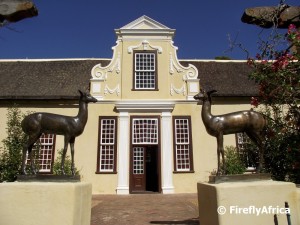The Vergelegen Wine Estate in Somerset West is less than an hour’s drive from Cape Town yet back in the 1700’s it took three days by ox wagon to get there. In 1700 Willem Adriaan van der Stel succeeded his father, Simon van der Stel, as governor of the Cape and it didn’t take him long to claim himself a modest 30,000 hactre piece of land just like his father had done with Constantia. The farm was on the slopes of the Hottentots Holland mountains with beautiful views of the Atlantic Ocean and was called ‘Vergelegen’ meaning ‘situated far away’ due to the distance from Cape Town. Willem Adriaan planted vines as well as fruit orchards and also started farming with cattle and sheep. Shortly after he left the Cape the estate was sold and divided into four separate farms namely Vergelegen, Lourensford, Morgenster and Cloetenburg.
The old Cape Dutch style homestead has been turned into a museum offering visitors a glimpse into a 300 years of Vergelegen’s existence showcasing select treasures of early Cape Furniture, objects and textiles.
Directly behind (or in front, depending how you look at it) the house stand five giant Camphor Trees. These trees are the oldest living, officially documented trees on the sub-continent and was planted by van der Stel somewhere between 1700 and 1706. The trees are officially protected and were proclaimed National Monuments in 1942.
To the side of the manor house visitors will find the Royal Oak. The tree was planted in 1928 and according to the first plaque under it was grown from one of the last acorns of King Alfred’s Oak at Blenheim Palace in England. A second plaque states that acorns from this oak was personally collected on 23 April 1947 by His Majesty King George VI for replanting in Windsor Great Park. Two other plaques commemorate the first visits to Vergelegen by Queen Elizabeth II (21 March 1995) and Prince of Wales and Duchess of Cornwall (5 November 2011).





Love those stately old trees.